Review for Maburaho Collection
Introduction
Blind buying anime? In this day and age of internet streaming? I must be off my rocker. If I haven’t seen a show to know if I like it or not, I spend a little too much time reading up about it, seeking out fan opinion, finding out what it’s about almost to the point of spoiling the show. But once in a blue moon, I throw caution to the wind and shell out on a series without knowing the first thing about it. What helps is a clearance sale where a 24 episode series is being sold for just over 10 Australian dollars. At that price, it’s worth taking a lucky dip on Maburaho.
Maburaho takes place in a world where magic is ubiquitous. Everyone has it, although not everyone is created equal when it comes to ability. At birth, everyone has an allocation of magic, simply put down to how many times they can use it in their lives. The average person has a few hundred spells, but when it comes to the magical elite, they have thousands, tens of thousands of uses of magic, a signifier of skill and magical heritage. Naturally children of the most skilled families attend the most elite academies, such as Aoi Campus High School.
That doesn’t explain why Kazuki Shikimori goes to Aoi Academy, as he got the short end of the stick when it comes to innate magic. He can only use it 8 times in his life. What’s worse, using up your magic means death, the body literally turns to ashes. It also doesn’t explain why he’s suddenly getting more than his fair share of female attention. The top student in his school, Kuriko Kazetsubaki wants to get into his pants, the sword wielding Rin Kamishiro has designs on his sword, and transfer student Yuna Miyama has already moved in, insisting that she’s his wife. It’s all down to his genes. He may have wimped out on magic himself, but his heritage contains some of the most acclaimed magic users in history, and any children he will sire with suitably strong girls will be the elite of the elite. His future might just be rosy... if only he could stop using magic!
24 episodes of Maburaho are spread across seven discs.
Disc 1: Bewitched and Bewildered
1. I Showed Up
2. It Fell
3. It Appeared
4. I Saw It
Disc 2: Magic & Mayhem
5. She Made It
6. We Were Found Out
7. We Met
8. Gone and Done It
Disc 3: The Witching Hour
9. He Used It
10. It Was Spent
11. I Opened It
12. He Disappeared
Disc 4: Ghost of Chance
13. He Came Back
14. We Were Trapped
15. He Ascended
Disc 5: Surprises and Suspicions
16. We Snooped
17. They Decided
18. They Set it Up... Ya see
Disc 6: Divine Intervention
19. It Changed... Ya See
20. She Delivered It
21. He Was Lit Up
Disc 7: The Wizards of Ahhhs!
22. He Kept It
23. We Were Seen
24. It Ended
Picture
Maburaho gets a 4:3 regular transfer. It’s an old show, and gets the vintage NTSC-PAL standards conversion treatment. In this day and age of HD transfers on Blu-ray, and native PAL or progressive NTSC DVDs, it doesn’t look good at all, with a soft image, blended frames and not much in the way of detail. Thankfully it’s not a bad conversion, with little if any ghosting or judder to worry about. The animation too is nice and simple, the bright, primary colours of a comedy, and the simpler character and world designs, the lower level of detail that you’d expect in an anime made for 480 line resolution TV broadcasts. It’s a fair animation, with likeable character designs, and plenty of fan service.
Sound
You have the choice between DD 5.1 Surround English, and 2.0 Stereo Japanese with optional subtitles and a signs only track. I gave the English dub a try, and while this isn’t a show worthy of a surround remix, it does its job well enough. The English voice actors are adequate in their roles, but it doesn’t flow as naturally as you might expect from modern dubs. I stuck with the original language track and that too is adequate, with characters cast appropriately for their stereotypes, but no one really standing out as giving a memorable performance.
Extras
You get seven discs in an Amaray fatpack, four discs on either side of two centrally hinged panels, a single disc on a third panel, and two discs on the inner faces of the case. The sleeve is reversible if the Australian ratings logos offend you. The discs present their content with animated menus and jacket pictures.
Disc 1
The Art of Maburaho is a 1:53 slideshow gallery featuring imagery from the show.
There are 0:43 of Japanese Promos.
Translator Notes is a 16:09 interview with translator Richard Kim, as he talks through the process of translating an anime into English. He also points out and explains some translation choices in the show, shedding more light on some culture specific references.
You get the textless credits, and trailers for Howl’s Moving Castle, Cromartie High School, and Full Metal Panic Fumoffu.
Disc 2
This time The Art of Maburaho lasts 2:56.
The voice actor commentary with Blake Shepard (Kazuki), and Luci Christian (Yamase) is actually a picture in picture featurette on episode 7. It lasts 21:52. Note to Funimation. This is how you do commentaries, interesting, informative, and entertaining, without being a waste of time.
The textless credits are joined by trailers for Chrono Crusade, Colorful, and Steel Angel Kurumi.
Disc 3
The Art of Maburaho lasts 1:46 on this disc.
The voice actor commentary on episode 12 with Tiffany Grant (Kuriko) is a conventional audio commentary.
The textless credits again are alongside trailers for Colorful, Steel Angel Kurumi, and Mezzo DSA.
Disc 4
The Art of Maburaho also lasts 1:46 on this disc.
The voice actor commentary on episode 13 features Jessica Boone (Yuna), and Monica Rial (Shino).
The textless credits are here too, with trailers once again for Colorful, Steel Angel Kurumi, and Mezzo DSA.
Disc 5
The Art of Maburaho lasts 2:34 on this disc.
There is an interview with the US Art Designer, Fumiko Chino that lasts 18:33.
The textless credits are here too, with trailers once again for Colorful, Steel Angel Kurumi, and Mezzo DSA.
Disc 6
This time the Art of Maburaho lasts 4:15.
You get the textless credits plus trailers for Mezzo DSA, Saiyuki Requiem the Movie, and Excel Saga: The Im-Perfect Collection.
Disc 7
One final time the Art of Maburaho lasts 3:12.
You get the textless credits, including three versions of the ending, plus trailers for Kaleido Star Collection, Gilgamesh, and D.N.Angel Collection.
Conclusion
Maburaho is another in a long line of anime, which is just about good enough to watch, but is completely unmemorable. Coming from the early 2000s, it conforms to the stereotypes of a typical harem comedy of the period, a little bit saucy, with a wimpy male protagonist lusted after by a group of girls, and the comedy coming from the situations that they find themselves in. It’s from before the time when the girls’ characterisations became more refined and pigeonholed, so you might hope for a little variety and creativity in the characterisations, as there used to be in the earlier harems, but Maburaho’s characters are mostly bland and simplistic. It’s just the tsundere, the wife, the childhood friend, and the sexpot.
The story is unspectacular too, relying heavily on a path blazed by Ken Akamatsu. As a harem comedy, it’s like Love Hina but without the heart. As a harem comedy with a magical premise, it’s like Negima but without the depth. Maburaho is shallow and you don’t care about any of the characters.
The story’s premise could have been interesting, a world where everyone is born with a allocation of magic, a number of times that they can cast spells before their magic runs out and they turn to ash and die. Kazuki has just eight spells that he can cast before he will die, unlike the hundreds and thousands that most people have, which doesn’t explain why he’s at an elite magic school (where no one ever seems to actually learn any magic), but it’s the quality of his magic that is impressive. Any spells he casts are big. What’s more, his genetic magical heritage actually gives a reason for the harem. The girls want his genes, they want to sire great magicians off him, and it’s purely a matter of power, at first. Of course once they get to know him, they get all mushy, and the usual harem antics ensue, girls competing for his attention, clumsy and awkward blushing moments and so on. All the while, Kazuki keeps using his magic for the most trivial of reasons.
Where Maburaho actually surprised me, and briefly interested me was around the halfway point, where the main character actually dies. It’s not much of a spoiler as nothing much really changes. Now we have a harem of girls all hovering around a ghost. Most of the interesting episodes, the odd moment of character development actually happens during the first half of the series, and the writing takes a nosedive in the second half, with characters becoming increasingly single note and bland. The writers also seem to pull out all manner of contrivance and daft plot twists to urge the show on to its conclusion, culminating in the most ridiculous revelation that a bunch of the supporting cast have actually been hanging around for the last 1000 years reliving some ancient love story, of which Kazuki is the reincarnation of the centre of a love triangle. It’s at this point I just gave up and waved my credulity farewell.
Maburaho is watchable enough. You can stick an episode on and comfortably veg out to it, and twist my arm and I’ll even admit that some of the episodes do elicit the odd chuckle. But it really is low tier stuff, a poor man’s Love Hina/Negima, and you wouldn’t want to shell out any significant cash on it.
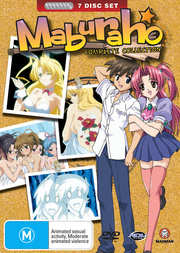


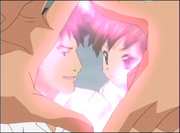

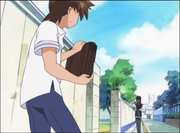
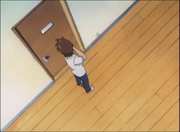
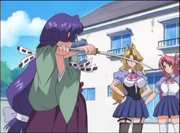
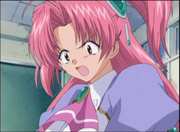

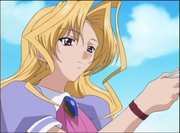
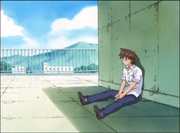
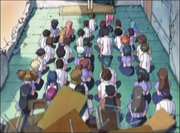
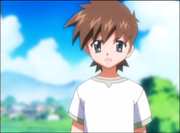
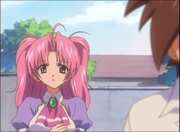
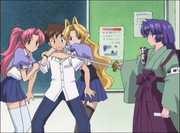

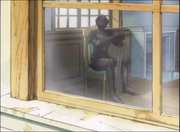
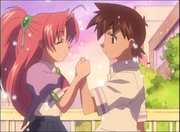

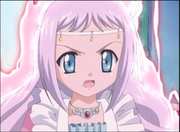
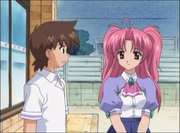
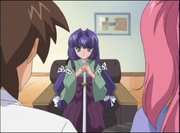
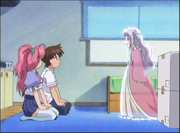
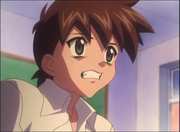
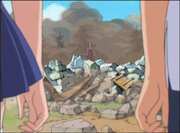
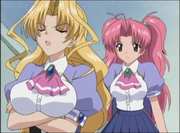

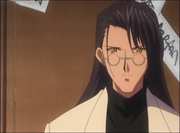
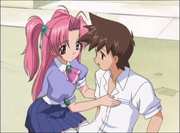
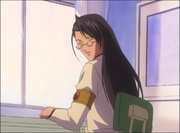



















































Your Opinions and Comments
Be the first to post a comment!